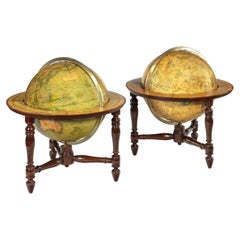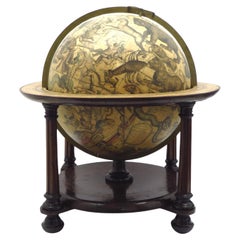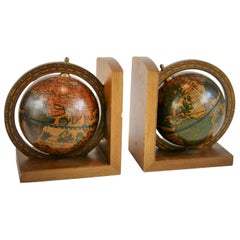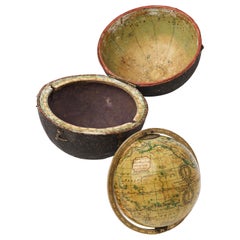John & William Newton Furniture
1
to
1
1
1
1
1
1
1
1
1
1
1
5,224
4,014
2,455
2,235
Creator: John & William Newton
Pair of Table Globes by J & W Newton, Dated 1820
By John & William Newton
Located in Lymington, Hampshire
A pair of 12 inch table globes by J & W Newton, dated 1820, each with 12 hand coloured gores, graduated meridian rings, set within ebonised stands with three turned legs. The terrest...
Category
1820s English Regency Antique John & William Newton Furniture
Materials
Wood
Related Items
A beautiful Celestial Table Globe produced by Gerard & Leonard Valk
By Gerard and Leonard Valk
Located in ZWIJNDRECHT, NL
A magnificent and very rare early 18th century celestial table globe produced by Gerard and Leonard Valk. Established at the end of the previous ...
Category
Early 18th Century Dutch Dutch Colonial Antique John & William Newton Furniture
Materials
Other
Pair Italian World Globe Bookends
Located in Douglas Manor, NY
3-455, pair Italian revolving globe bookends.
Category
1970s Vintage John & William Newton Furniture
Materials
Fruitwood
Terrestrial Globe By G. Thomas
Located in Brussels, Brussels
Very beautiful Terrestrial Globe from the beginning of the 20th century circa 1910 by G.Thomas publisher Paris
The Terrestrial Globe has a very beautiful blackened wooden base with ...
Category
Early 20th Century French Napoleon III John & William Newton Furniture
Materials
Paper
19th CENTURY PAIR OF SMALL WORLD GLOBES
Located in Firenze, FI
Unique and fascinating pair of small globes, made with artisanal care by Italian manufacturers in the 19th century and hand painted on fine paper. These small globes are mounted on a...
Category
19th Century Italian Antique John & William Newton Furniture
Materials
Brass
Italian World Globe Bookends, Pair
Located in New York, NY
An Italian pair of world globe bookends with brass accents, circa mid-20th century, Italy. A great pair for an office, library, living room, etc. Marked 'Made in Italy' on back as sh...
Category
Mid-20th Century Italian Mid-Century Modern John & William Newton Furniture
Materials
Brass
Terrestrial Globe By Philips
Located in Brussels, Brussels
Very beautiful Terrestrial Globe made by Philips Londre based on the maps of Taride Paris Boulevard Saint Germain
The Terrestrial Globe has a very beautiful cast iron base decorated...
Category
20th Century British Napoleon III John & William Newton Furniture
Materials
Paper
Heirloom Globe by Replogle
By Replogle Globes
Located in Pasadena, TX
1970s Replogle Illuminated glass globe on a dark brown walnut stand.
Globe has a full 360 degree turning function. Working condition and has a switc...
Category
Mid-20th Century North American Industrial John & William Newton Furniture
Materials
Steel
An exceptional pair of BLAEU table globes
By Willem Blaeu
Located in ZWIJNDRECHT, NL
A very rare set of globes, 9 inch / 23cm, with an overall height of 38 cm, Amsterdam, dated 1602, but published after 1621. In their original stands with circular wooden horizon rings, covered with printed paper, supported by four legs and brass meridian rings supported by a single column.
The terrestrial and celestial globe are made up of a set of 12 engraved gores, heightened in gold and Arctic ice caps, printed on paper and mounted on a plaster sphere of papier maché. Each sphere is mounted in a graduated brass meridian ring with the production number stamped at the back of the ring. Both globes are mounted on four-legged ebonized oak Dutch stands, which support the horizon ring. The legs are connected by two crossbeams which support a circular base plate with central support for the meridian ring. The horizon rings are covered with printed paper. With usual defects: paper equinoctial tables present gaps that are filled and restored; small splits along gores; several partially deleted entries; on the globe, the date 1602 and the text of the cartouche in America, are illegible ; small scattered spots but in general in good condition for such an early globe pair of which presently only 19 pair are recorded.
These 9-inch globes are among the rarest since very few copies of them are known to exist, in comparison with the smaller or larger globes of Blaeu (4, 6, 13.5, and 26 inches). Blaeu's terrestrial globes were highly valued and were much in demand, because of the care with which they had been prepared, because of the efforts to give the latest information on discoveries, and because of the loxodromic lines that made them of special value to navigators.
His celestial globes were appreciated for the fact that he had been the pupil of Tycho Brahe, who was himself known to be the greatest astronomer of his time.
Willem Janszoon Blaeu (1571–1638), originally trained in astronomy, he quickly became a leading maker of maps, atlases and instruments. Blaeu’s globes were luxury items for wealthy and intellectual merchants and nobility who benefited from Blaeu’s access through the Dutch East India Company to the latest navigational discoveries and geographical information.
Willem Jansz Blaeu collected information that Dutch mariners gathered from around world and brought back to Amsterdam. Crews were instructed to record information about the lands they visited and the skies they saw. Blaeu incorporated these observations in maps and globes. Through his web of contacts and thanks to assiduous research, he was also able to obtain the most recent information about the latest discoveries in the western hemisphere and the South Pacific, where Dutch explorers were particularly active at the time.
Since the globe was published after 1618, Blaeu was able to include the discoveries made by Henry Hudson in his attempt to find a passage to the East Indies. He also included recent Pacific discoveries of the celebrated voyages of Willem Cornelis Schouten and Jacob Le Maire, who both traversed the South Pacific and the Atlantic. The findings of Schouten and Le Maire in the Tierra del Fuego region are also incorporated.
The Strait of Le Maire is drawn and the hypothetical southern continent is labelled “Terra Australis Incognita Magalanica”. Olivier van Noort’s track is drawn and labelled. His route is indicated with a broken line and the words: “Navigationis Olivierij ductus” (several times). There are various decorative features, such as animals on the different continents, many ships on the high seas and allegorical and mythical figures around the cartouches.
The nine-inch globe is not just a smaller version of the one published in 1599. Drawings of animals and people do often correspond to those on the earlier globe, but Blaeu made several significant changes.
- The west coast of North America is drawn differently and the river system of Brazil is altered.
- The hypothetical southern continent is labelled: Terra Australis Incognita Magallanica.
- There are nine ocean names in handsome curling letters: Mare Congelatum, Mare Atlanticum, Oceanus Aethiopicus, Mare Arabicum et Indicum, Mare di India, Oceanus Chinensis, Mar del Zur, Mare Pacificum, Mar del Nort.
- Willem Blaeu...
Category
17th Century European Dutch Colonial Antique John & William Newton Furniture
Materials
Other
19th Century French Table Globe / "Globe Terrestre" by J. Forest / Paris
Located in Dallas, TX
A well proportioned paper, plaster terrestrial globe standing on a turned ebonized base. GLOBE TERRESTRE
"Dressé par J. FOREST
GÉOGRAPHE
EN VENTE A PARIS
Chez l'Auteur
17 Rue de ...
Category
Late 19th Century French Late Victorian Antique John & William Newton Furniture
Materials
Plaster, Paper
A huge pair of 21 inches Cruchley Library Globes
By G.F. Cruchley
Located in ZWIJNDRECHT, NL
G.F. Cruchley (UK, 1796-1880)
London ca 1850
A magnificent pair of terrestrial and celestial globes. Equatorial table engraved with the signs of the zodiac and resting on 3 mahogany molded feet held by a compass at the spacer. With graduated brass meridian circles and time clocks. The terrestrial globe is inscribed in a cartouche: Cruchley's new terrestrial globe from the most recent and best authorities. Exhibiting the discoveries in equatorial Africa, north pole. And the new settlements and divisions in Australia, New Zealand, Californa, Texas, &c. London. Sold by Gould and Porter opticians 181 strand WC. The celestial globe is inscribed in a cartouche: Cruchleys new celestial globe on which is accurately laid down the whole of the stars and nebule contained in the astronomical catalogue of the Reverend Mr. Wollaston F.R.S. Also from the authorities Flamstead, De La Caille, Hevellus, Bradley, Herschel, Maskelyne, &c. Ands the limits of each constellation determined by a boundary line. London, published by G.F. Cruchley, map-seller & globe maker, 81 Fleet street.
Signed: CRUCHLEY in London England, circa 1850 H. 125 cm Diam. 53 cm (21 inches) Diam. 25 cm compasses The two spheres are in a perfect state of freshness and are perfectly legible.
The condition of both the globes is very good. There have been some professional repairs to some damaged gores. The Terrestrial globe in good conserved and legible condition, it has areas of rubbing, retouching, and slight discoloration. The Celestial globe is also in good conserved and legible condition with areas of rubbing, retouching and slight discoloration. The gores themselves have been cleaned and revarnished. The splendid mahogany legs and moulded feet are in first class condition. Each globe consists of 12 hand coloured copper engraved gores over a paper-maché hollow core, made up of two hemispheres joined at the equator and covered with a layer of plaster. There are paper horizon rings, made up of a series of concentric circles, displaying the months of the year, the signs of the zodiac and wind directions.
THE TERRESTRIAL GLOBE.
The globe provides much detailed information, and was accurate up to the date of production, which in this case is the mid-19th century. It shows the latest discoveries and developments that had taken place. It displays names and territories that were once familiar to the people of the age, 150 years into the future! In Asia for example, there are places like ‘Little Bucharia’, ‘Little and Greater Tartary’, ‘Russia in Asia.’ Undoubtedly, the continent that has changed more than any other is Africa. So many African countries that we know and recognise now, had different, perhaps more ‘Colonial’ names more than a century and a half ago. There was ‘Nubia’ (Sudan/Egypt), ‘Abbyssinia’ (Ethiopia), ‘Cape Colony’ (South Africa), ‘Dahomey’ (Benin) but to name a few. Australia was a little over 50 years away from its union via ‘Federation’ in 1901. This brought about the Commonwealth of Australia. However, in 1850 they were six separate British selfserving colonies, ruled directly from England.
In North America, both Los Angeles and San Francisco are incorporated as cities into California - as it becomes the 31st U.S. state. Much of mid-western and western USA were known as ‘The Western Territory’ & ‘The Missouri Territory’, Florida was still refered to as ‘East & West Florida’. Canada was split into ‘Canada East’ & ‘Canada West.’ Canada East was primarily (for historical reasons) French-speaking, and Canada West primarily Englishspeaking. Much of Western Canada remained unexplored and undeveloped. In Europe, there was still the ‘Russian Empire’, the ‘Ottoman Empire’, the ‘AustroHungarian Empire’, and the German ‘Prussian Empire.’
THE CELESTIAL GLOBE.
The Celestial Globe displays the stars, the constellations, clusters and nebulae in a beautiful and well thought out manner. Mythical figures and signs of the zodiac are seen. The equinoctial and solistitial colures are graduated in degrees. Although the colour is somewhat muted, it takes nothing away from the overall beauty and the undoubted aesthetic qualities of the globe.
Historically, globes are among the most ancient scientific instruments known to man. They can be dated back over two millennia, and are still manufactured to this day. The earliest tradition of globe making is mainly concerned with celestial globes – man...
Category
1850s British Victorian Antique John & William Newton Furniture
Materials
Other
Pair of Philip & Son Globes, circa 1946
By George Philip & Son
Located in London, GB
A wonderful set of Terrestrial and Celestial 12 inch globes by George Philip and Son. Presented on brass inclined plain mounts attached to original turned ebonized wooden bases and uprights with axes secured at the top by brass acorn finials. Unusually, the terrestrial globe has a copyright date shown under the cartouche, 1946.
The celestial globe is printed in beige against a dark blue background and shows the constellations and many named stars. Solid lines connect the stars within constellations rather than illustrating them as mythological and other figures.? A cartouche is present that includes the title and maker's address.
When looking at the stars from Earth the viewpoint is effectively inside a celestial sphere. The surface of a celestial globe shows the star field as a projection viewed from the outside and is therefore reversed, with the constellations appearing as their mirror images.
The terrestrial globe is printed in several colours and comprises of twelve coated lithographic paper gores with polar calottes over a twelve inch card sphere. The age of the globe has been confirmed by the political borders and named cities displayed. The globe is nicely detailed and has a grid network of parallels and meridians. It shows all the continents and countries as they were at the time it was printed and also indicates all the principal steamship routes with distances in nautical miles. The globe also has a printed Analemma - a diagram showing the declination of the Sun for every day in the year and the equation of time. The Analemma therefore shows the position of the Sun in the sky as seen from a fixed location on Earth at the same mean solar time, as the sun's position varies over the course of a year. A cartouche is present that includes the title and maker's address.
Dimensions of each globe: 30.5 cm/12 inches (diameter) x 59 cm/23 1/4 inches (max height).
George Philip, (1800–1882) was a cartographer and map publisher. He founded George Philip & Sons in 1834 in Liverpool primarily as a bookseller and stationer, but rapidly expanding to become a publisher of primarily maps, atlases and educational works. He had one son, also George (1823–1902), who was admitted to the business in 1848.
George senior was born in Huntly, Aberdeenshire and by 1819 he had become assistant to the Liverpool bookseller, William Grapel before going on to start his own business. He used cartographers (such as John Bartholomew the elder, August Petermann, and William Hughes) to produce maps on copper plates. Philip then had these printed and hand-coloured by his women tinters. The business expanded rapidly and by the time he produced his county maps of 1862 he was using machine...
Category
1940s British Vintage John & William Newton Furniture
Materials
Brass
Pair of Fine Desk Globes by J. Cary, 1816 and 1824
Located in Amsterdam, NL
A pair of desk globes by J. Cary
“Cary’s New Terrestrial Globe delineated from the best Authorities extant; exhibiting the late discoveries toward the North Pole and every improve...
Category
Early 19th Century Antique John & William Newton Furniture
Materials
Other
Previously Available Items
19th Century English Pocket Globe By Newton, London 1817
By John & William Newton
Located in Milano, IT
John (1759-1844) and William (1786-1861) Newton
Pocket Globe
London, January 1, 1817
The globe is kept in its original black leather case.
Diameter: Globe 3 in (7.7 cm); Case 3...
Category
1810s English George III Antique John & William Newton Furniture
Materials
Leather, Paper
John & William Newton furniture for sale on 1stDibs.
John & William Newton furniture are available for sale on 1stDibs. These distinctive items are frequently made of wood and are designed with extraordinary care. There are many options to choose from in our collection of John & William Newton furniture, although brown editions of this piece are particularly popular. Many of the original furniture by John & William Newton were created in the Regency style in united kingdom during the 19th century. If you’re looking for additional options, many customers also consider furniture by and Cary’s. Prices for John & William Newton furniture can differ depending upon size, time period and other attributes — on 1stDibs, these items begin at $22,297 and can go as high as $27,450, while a piece like these, on average, fetch $24,874.



